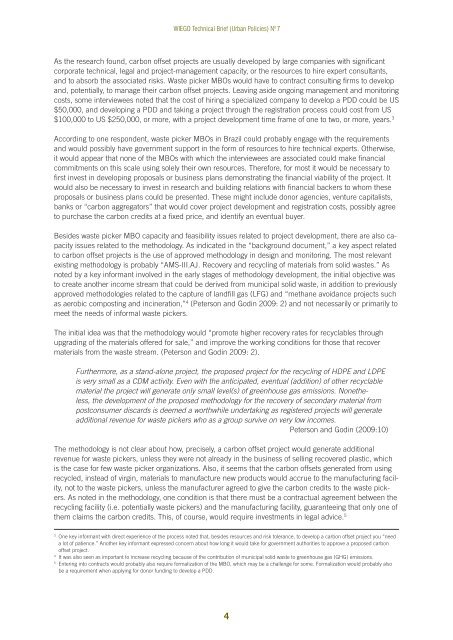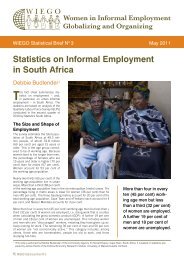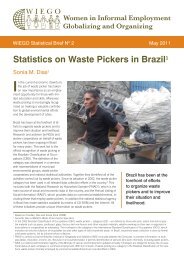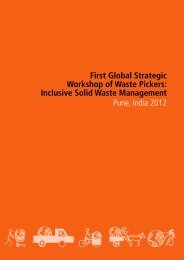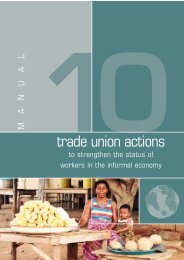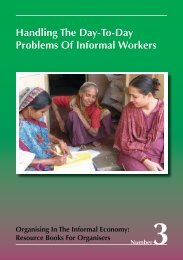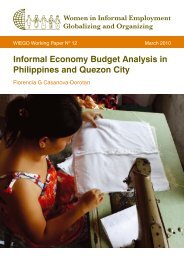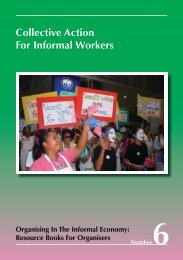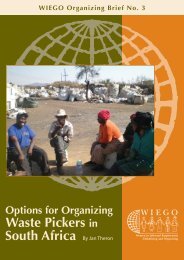Waste Pickers and Carbon Finance: Issues to Consider - WIEGO
Waste Pickers and Carbon Finance: Issues to Consider - WIEGO
Waste Pickers and Carbon Finance: Issues to Consider - WIEGO
- No tags were found...
Create successful ePaper yourself
Turn your PDF publications into a flip-book with our unique Google optimized e-Paper software.
<strong>WIEGO</strong> Technical Brief (Urban Policies) N o 7As the research found, carbon offset projects are usually developed by large companies with significantcorporate technical, legal <strong>and</strong> project-management capacity, or the resources <strong>to</strong> hire expert consultants,<strong>and</strong> <strong>to</strong> absorb the associated risks. <strong>Waste</strong> picker MBOs would have <strong>to</strong> contract consulting firms <strong>to</strong> develop<strong>and</strong>, potentially, <strong>to</strong> manage their carbon offset projects. Leaving aside ongoing management <strong>and</strong> moni<strong>to</strong>ringcosts, some interviewees noted that the cost of hiring a specialized company <strong>to</strong> develop a PDD could be US$50,000, <strong>and</strong> developing a PDD <strong>and</strong> taking a project through the registration process could cost from US$100,000 <strong>to</strong> US $250,000, or more, with a project development time frame of one <strong>to</strong> two, or more, years. 3According <strong>to</strong> one respondent, waste picker MBOs in Brazil could probably engage with the requirements<strong>and</strong> would possibly have government support in the form of resources <strong>to</strong> hire technical experts. Otherwise,it would appear that none of the MBOs with which the interviewees are associated could make financialcommitments on this scale using solely their own resources. Therefore, for most it would be necessary <strong>to</strong>first invest in developing proposals or business plans demonstrating the financial viability of the project. Itwould also be necessary <strong>to</strong> invest in research <strong>and</strong> building relations with financial backers <strong>to</strong> whom theseproposals or business plans could be presented. These might include donor agencies, venture capitalists,banks or “carbon aggrega<strong>to</strong>rs” that would cover project development <strong>and</strong> registration costs, possibly agree<strong>to</strong> purchase the carbon credits at a fixed price, <strong>and</strong> identify an eventual buyer.Besides waste picker MBO capacity <strong>and</strong> feasibility issues related <strong>to</strong> project development, there are also capacityissues related <strong>to</strong> the methodology. As indicated in the “background document,” a key aspect related<strong>to</strong> carbon offset projects is the use of approved methodology in design <strong>and</strong> moni<strong>to</strong>ring. The most relevantexisting methodology is probably “AMS-III.AJ. Recovery <strong>and</strong> recycling of materials from solid wastes.” Asnoted by a key informant involved in the early stages of methodology development, the initial objective was<strong>to</strong> create another income stream that could be derived from municipal solid waste, in addition <strong>to</strong> previouslyapproved methodologies related <strong>to</strong> the capture of l<strong>and</strong>fill gas (LFG) <strong>and</strong> “methane avoidance projects suchas aerobic composting <strong>and</strong> incineration,” 4 (Peterson <strong>and</strong> Godin 2009: 2) <strong>and</strong> not necessarily or primarily <strong>to</strong>meet the needs of informal waste pickers.The initial idea was that the methodology would “promote higher recovery rates for recyclables throughupgrading of the materials offered for sale,” <strong>and</strong> improve the working conditions for those that recovermaterials from the waste stream. (Peterson <strong>and</strong> Godin 2009: 2).Furthermore, as a st<strong>and</strong>-alone project, the proposed project for the recycling of HDPE <strong>and</strong> LDPEis very small as a CDM activity. Even with the anticipated, eventual (addition) of other recyclablematerial the project will generate only small level(s) of greenhouse gas emissions. Nonetheless,the development of the proposed methodology for the recovery of secondary material frompostconsumer discards is deemed a worthwhile undertaking as registered projects will generateadditional revenue for waste pickers who as a group survive on very low incomes.Peterson <strong>and</strong> Godin (2009:10)The methodology is not clear about how, precisely, a carbon offset project would generate additionalrevenue for waste pickers, unless they were not already in the business of selling recovered plastic, whichis the case for few waste picker organizations. Also, it seems that the carbon offsets generated from usingrecycled, instead of virgin, materials <strong>to</strong> manufacture new products would accrue <strong>to</strong> the manufacturing facility,not <strong>to</strong> the waste pickers, unless the manufacturer agreed <strong>to</strong> give the carbon credits <strong>to</strong> the waste pickers.As noted in the methodology, one condition is that there must be a contractual agreement between therecycling facility (i.e. potentially waste pickers) <strong>and</strong> the manufacturing facility, guaranteeing that only one ofthem claims the carbon credits. This, of course, would require investments in legal advice. 53One key informant with direct experience of the process noted that, besides resources <strong>and</strong> risk <strong>to</strong>lerance, <strong>to</strong> develop a carbon offset project you “needa lot of patience.” Another key informant expressed concern about how long it would take for government authorities <strong>to</strong> approve a proposed carbonoffset project.4It was also seen as important <strong>to</strong> increase recycling because of the contribution of municipal solid waste <strong>to</strong> greenhouse gas (GHG) emissions.5Entering in<strong>to</strong> contracts would probably also require formalization of the MBO, which may be a challenge for some. Formalization would probably alsobe a requirement when applying for donor funding <strong>to</strong> develop a PDD.4


